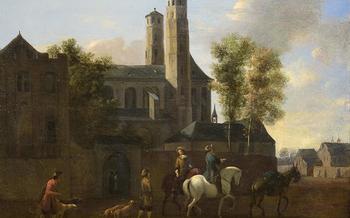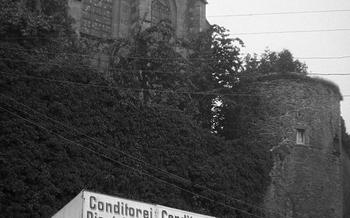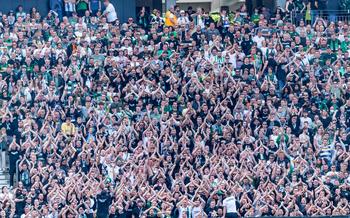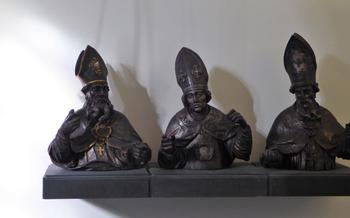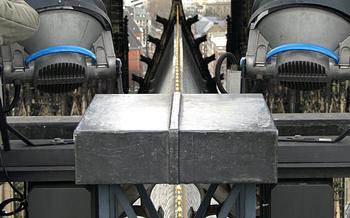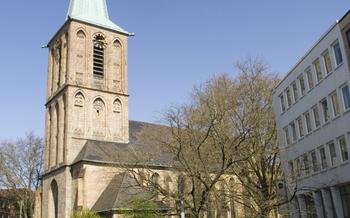
St. Andreas
- The St. Andreas Church: A Majestic Symbol of Cologne's Rich Heritage
- The History of the St. Andreas Church
- The Architecture of the St. Andreas Church
- The Religious Significance of the St. Andreas Church
- The Cultural Heritage of the St. Andreas Church
- The Twin Towers of the St. Andreas Church
- The Stained-Glass Windows of the St. Andreas Church
- The Interior of the St. Andreas Church
- The Vaulted Ceilings of the St. Andreas Church
- The Ornate Carvings of the St. Andreas Church
- The Relics of St. Andreas and their Significance to the Church
- The Role of the St. Andreas Church in the Catholic Church and the Community of Cologne
- The Role of the St. Andreas Church in Shaping Cologne's Cultural Identity
- Local Legends and Traditions Associated with the St. Andreas Church
- Insider Tip
The St. Andreas Church: A Majestic Symbol of Cologne's Rich Heritage
In the heart of Cologne, Germany, stands the magnificent St. Andreas Church, a testament to the city's rich history and cultural heritage. A masterpiece of Gothic architecture, this awe-inspiring edifice boasts twin towers that pierce the skyline and intricate stained-glass windows that illuminate the interior with a kaleidoscope of colors. Step into this sacred space, and you will be transported back in time, surrounded by centuries of faith, devotion, and architectural brilliance.
The St. Andreas Church is not merely a place of worship; it is a living testament to the resilience of the human spirit. Having survived wars, conflicts, and the passage of time, the church stands as a symbol of Cologne's enduring spirit and its unwavering commitment to preserving its cultural legacy.
The History of the St. Andreas Church
The origins of the St. Andreas Church can be traced back to the 4th century AD, when a small Christian community is believed to have existed on the site. The first mention of a church dedicated to St. Andreas in Cologne appears in a document from 855 AD. The original church was a simple wooden structure, but it was later rebuilt in stone in the 11th century. The current Gothic-style church was built between 1220 and 1330 AD, and it has undergone several renovations and expansions over the centuries.
Throughout its history, the St. Andreas Church has played a significant role in the religious and cultural life of Cologne. It has served as a place of worship for the local community, and it has been a center of pilgrimage for centuries. The church has also been a witness to many important historical events, including the coronation of Otto IV as Holy Roman Emperor in 1209 AD and the signing of the Peace of Cologne in 1679 AD.
Despite its age and the many challenges it has faced, the St. Andreas Church has survived through various wars and conflicts. It was damaged during the Second World War, but it was later restored to its former glory. Today, the church stands as a testament to the resilience of the Catholic faith and the enduring spirit of the people of Cologne.
The Architecture of the St. Andreas Church
The St. Andreas Church is a magnificent example of Gothic architecture, with its distinctive pointed arches, ribbed vaults, and flying buttresses. The church's exterior is characterized by its intricate carvings and sculptures, which depict scenes from the Bible and the life of St. Andreas. The two towers of the church, which rise to a height of over 60 meters, are a defining feature of the Cologne skyline.
The interior of the church is equally impressive, with its vaulted ceilings, ornate carvings, and stained-glass windows. The church's nave is divided into three aisles by slender columns, which support the vaulted ceilings. The vaults are decorated with intricate rib patterns, which create a sense of lightness and airiness. The walls of the church are adorned with ornate carvings, which depict scenes from the Bible and the life of St. Andreas.
The St. Andreas Church is a testament to the skill and craftsmanship of the medieval builders. The church's architecture is a unique blend of Gothic and Romanesque elements, which creates a harmonious and visually stunning building.
The Religious Significance of the St. Andreas Church
The St. Andreas Church holds profound religious significance for the people of Cologne, serving as a place of worship and pilgrimage for centuries. It is dedicated to Saint Andreas, one of the twelve apostles of Jesus Christ, whose relics are believed to be enshrined within the church. The presence of these relics has made the St. Andreas Church a prominent destination for pilgrims from around the world, who come to pay homage to the saint and seek his intercession.
The church's religious significance is further enhanced by its role in the Catholic Church and the community of Cologne. It serves as a center for worship, prayer, and spiritual guidance, hosting regular masses, services, and special events throughout the year. The church's clergy and staff are dedicated to providing spiritual support and guidance to the local community, fostering a sense of belonging and unity among its members. The St. Andreas Church is truly a sacred space that fosters a deep connection between the faithful and their faith.
The Cultural Heritage of the St. Andreas Church
The St. Andreas Church stands as a testament to Cologne's rich cultural heritage. Its imposing presence and intricate design have shaped the city's skyline and identity for centuries. The church has witnessed countless events that have left an indelible mark on Cologne's history, from religious ceremonies and festivals to political gatherings and protests.
Over the years, the church has become intertwined with local legends and traditions. According to one legend, the church was built on the site where St. Andreas, the patron saint of Cologne, was martyred. This legend has contributed to the church's status as a place of pilgrimage and a symbol of the city's Christian heritage.
The St. Andreas Church has played a significant role in shaping Cologne's cultural identity. It has been a venue for concerts, art exhibitions, and other cultural events, contributing to the city's vibrant cultural scene. The church's impressive architecture and rich history have inspired countless artists, writers, and musicians, who have found inspiration in its beauty and grandeur.
The church's cultural significance extends beyond its walls. It is a beloved landmark that has become synonymous with Cologne. Its twin towers are a familiar sight, and its presence is deeply rooted in the city's collective consciousness. The St. Andreas Church is a symbol of Cologne's resilience, its cultural diversity, and its enduring spirit.
The Twin Towers of the St. Andreas Church
Ascending the Twin Towers for a Panoramic Vista
The twin towers of the St. Andreas Church stand proudly as iconic landmarks of Cologne's cityscape. These magnificent towers, with their intricate Gothic details and soaring heights, have become synonymous with the church and offer visitors an unforgettable experience.
The towers, constructed in the 14th century, are a testament to the architectural prowess of the time. Their unique design, featuring open tracery and intricate carvings, showcases the transition from Romanesque to Gothic architecture. The towers' harmonious proportions and elegant spires create a captivating silhouette against the Cologne skyline.
One of the highlights of visiting the St. Andreas Church is the opportunity to ascend the twin towers. A winding staircase leads visitors to the top, providing breathtaking panoramic views of Cologne. From this vantage point, visitors can marvel at the city's landmarks, including the mighty Rhine River, the iconic Cologne Cathedral, and the surrounding urban landscape.
The experience of climbing the towers is both physically and spiritually rewarding. The sense of accomplishment upon reaching the top is matched by the awe-inspiring views that unfold before the eyes. Visitors can take a moment to reflect on the rich history and significance of the church while soaking in the beauty of Cologne from above.
The Stained-Glass Windows of the St. Andreas Church
The stained-glass windows of the St. Andreas Church are a breathtaking sight, filling the interior with vibrant colors and intricate designs. Created between the 13th and 16th centuries, these windows are considered masterpieces of Gothic art and craftsmanship.
The windows depict a variety of scenes from the Bible, the life of St. Andreas, and the history of Cologne. The vibrant colors and intricate details bring the stories to life, creating a sense of awe and wonder for visitors.
One of the most striking windows is the "Martyrdom of St. Andreas," which shows the saint being crucified on an X-shaped cross. The window is a poignant reminder of St. Andreas's suffering and sacrifice for his faith.
Another notable window is the "Adoration of the Magi," which depicts the three wise men presenting gifts to the infant Jesus. The window is a beautiful example of the Gothic style, with its rich colors and intricate details.
The stained-glass windows of the St. Andreas Church are a testament to the skill and artistry of the medieval craftsmen who created them. They are a valuable part of Cologne's cultural heritage and a must-see for any visitor to the city.
The Interior of the St. Andreas Church
The interior of the St. Andreas Church is a testament to the Gothic style's grandeur and opulence. The nave, with its towering vaulted ceilings, creates a sense of awe and inspiration. The use of light and space is masterful, with large windows illuminating the interior and casting intricate shadows on the walls.
The church's furnishings are equally impressive. The altar, a masterpiece of craftsmanship, is adorned with intricate carvings and gilding. The pulpit, with its delicate tracery, is a testament to the skill of the medieval artisans who created it. The pews, with their intricate carvings and comfortable cushions, invite visitors to linger and contemplate the church's beauty.
The overall effect of the interior is one of harmony and balance. The use of natural materials, such as wood and stone, creates a warm and inviting atmosphere. The attention to detail and the skillful execution of the artwork make the St. Andreas Church a true masterpiece of Gothic architecture.
The Vaulted Ceilings of the St. Andreas Church
The vaulted ceilings of the St. Andreas Church are a testament to the architectural prowess and artistic vision of the medieval builders. Constructed using a series of intersecting arches, the vaults create a sense of height and grandeur within the church's interior. The intricate web of ribs and vaults is not merely decorative; it serves a structural purpose, distributing the weight of the roof evenly across the walls.
The vaults are adorned with a variety of carvings and sculptures, adding to the overall aesthetic appeal of the church. These carvings depict religious scenes, biblical figures, and intricate geometric patterns. The interplay of light and shadow on the vaults creates a dramatic effect, enhancing the sense of awe and inspiration within the sacred space.
The vaulted ceilings of the St. Andreas Church are not just architectural marvels; they also hold symbolic and religious significance. The upward sweep of the vaults represents the aspiration of the human soul towards heaven. The intricate carvings and sculptures serve as reminders of the divine presence and the stories of faith and redemption that have unfolded within these walls for centuries.
The Ornate Carvings of the St. Andreas Church
The St. Andreas Church is adorned with intricate and awe-inspiring carvings that narrate stories from the Bible and the life of St. Andreas. These carvings, a testament to the skill and artistry of medieval craftsmen, are found throughout the church, gracing the walls, pillars, and various architectural elements.
The history of these carvings dates back to the church's construction in the 13th century. Over the years, numerous artisans contributed to the church's ornamentation, leaving their unique mark on its interior. The carvings depict a wide range of subjects, from biblical scenes to mythical creatures and symbolic motifs.
One of the most striking features of the carvings is their attention to detail. The artists meticulously rendered each figure, capturing their expressions, gestures, and clothing with remarkable precision. The carvings also showcase a variety of techniques, from delicate bas-reliefs to intricate three-dimensional sculptures.
Among the most notable carvings is the depiction of the Last Supper, located in the choir area of the church. This intricate carving portrays Jesus and his disciples gathered around a table, each figure displaying a unique expression and posture. The table is laden with food and drink, and the overall composition exudes a sense of intimacy and reverence.
Another highlight is the carving of St. Andreas himself, found near the main altar. This larger-than-life sculpture depicts the saint standing triumphantly, holding a cross in his hand. The carving captures the strength and determination of St. Andreas, who is revered as the patron saint of Cologne.
These ornate carvings not only enhance the visual appeal of the St. Andreas Church but also serve as a powerful reminder of the rich history and spiritual significance of this sacred space. They invite visitors to contemplate the stories and teachings depicted in the carvings, deepening their understanding of the Christian faith and the life of St. Andreas.
The Relics of St. Andreas and their Significance to the Church
The St. Andreas Church in Cologne holds a significant religious treasure: the relics of St. Andreas, one of the twelve apostles of Jesus Christ. These relics, believed to be fragments of the saint's bones, have a profound religious and cultural significance for the church and the Catholic community of Cologne.
The history of the relics dates back to the early days of Christianity, when St. Andreas was martyred in Greece. According to tradition, his remains were brought to Cologne by the Empress Theophanu in the 10th century. The relics were then enshrined in the St. Andreas Church, where they have remained ever since, becoming a focal point of devotion and pilgrimage.
The relics of St. Andreas are not only a symbol of his martyrdom and sacrifice but also a source of spiritual inspiration and guidance for the faithful. Pilgrims from all over the world come to Cologne to venerate the relics and seek the intercession of St. Andreas. The church holds regular services and devotions dedicated to the saint, and his feast day on November 30th is celebrated with great solemnity.
The significance of the relics extends beyond the religious realm. They have played a crucial role in shaping the cultural and historical identity of Cologne. The presence of St. Andreas' relics has made the city a significant pilgrimage site, attracting visitors from all walks of life. The church has become a symbol of Cologne's rich Christian heritage and a testament to the enduring faith of its people.
The Role of the St. Andreas Church in the Catholic Church and the Community of Cologne
As a center of worship, the St. Andreas Church is a cornerstone of the Catholic community in Cologne. Regular masses, prayer services, and devotions are held within its hallowed walls, fostering a deep sense of spirituality and belonging among the faithful. The church's majestic architecture and serene atmosphere provide an ideal setting for prayer and contemplation, inviting visitors to find solace and inspiration in their spiritual journey.
Beyond its religious significance, the St. Andreas Church plays a vital role in the social and charitable fabric of Cologne. It actively participates in various community outreach programs, offering assistance to those in need. The church's charitable initiatives include providing food and shelter to the homeless, supporting educational programs for underprivileged children, and organizing events to promote social cohesion. Through these endeavors, the St. Andreas Church demonstrates its commitment to social justice and the well-being of the community it serves.
Moreover, the church maintains a strong relationship with local organizations and institutions, collaborating on projects that benefit the community as a whole. It works closely with schools, hospitals, and cultural groups to foster interfaith dialogue, promote understanding, and create a harmonious and inclusive society. The St. Andreas Church's commitment to community engagement and its role as a beacon of hope and support have earned it a revered position in the hearts of Cologne's citizens.
The Role of the St. Andreas Church in Shaping Cologne's Cultural Identity
The St. Andreas Church has played a significant role in shaping Cologne's cultural identity through its contributions to art, music, and local traditions. The church has been a patron of the arts for centuries, commissioning and displaying works by renowned artists. These artworks, which include paintings, sculptures, and stained-glass windows, have enriched the city's cultural heritage and continue to inspire visitors and residents alike.
In addition to its role in the visual arts, the St. Andreas Church has also been a major contributor to Cologne's music scene. The church's choir is one of the oldest and most respected in Germany, and its performances of sacred music have garnered international acclaim. The church has also hosted numerous concerts and recitals by renowned musicians, further enhancing the city's reputation as a cultural hub.
Beyond its contributions to art and music, the St. Andreas Church has also been instrumental in promoting local traditions and customs. The church has been a focal point for religious processions and festivals for centuries, and its participation in these events has helped to preserve and celebrate the city's unique cultural heritage. The church's commitment to local traditions has also extended to its support of local crafts and businesses, contributing to the city's vibrant cultural economy.
Overall, the St. Andreas Church has played a multifaceted role in shaping Cologne's cultural identity. Through its patronage of the arts, its contributions to music, and its promotion of local traditions, the church has left an enduring mark on the city's cultural landscape.
Local Legends and Traditions Associated with the St. Andreas Church
The St. Andreas Church is steeped in local legends and traditions that have been passed down through generations. One of the most famous legends is that of St. Andreas himself, who is said to have visited Cologne in the 1st century AD and preached Christianity to the local population. According to legend, St. Andreas was martyred in Greece, and his relics were later brought to Cologne, where they are now enshrined in the church.
Another legend associated with the church tells the story of a young woman named Agnes, who was said to have been cured of a terminal illness after praying to St. Andreas. In gratitude, Agnes donated her long, flowing hair to the church, which was then used to create a beautiful tapestry that still hangs in the church today.
The St. Andreas Church is also closely associated with the local tradition of the Cologne Carnival. During the carnival, the church is decorated with colorful streamers and balloons, and a special Mass is held to celebrate the feast of St. Andreas. The church is also a popular destination for carnival revelers, who come to admire the church's beautiful architecture and to take part in the festivities.
These are just a few of the many legends and traditions that are associated with the St. Andreas Church. These stories have helped to shape the church's unique identity and have made it a beloved landmark in the city of Cologne.
Insider Tip
For a serene and contemplative experience, visit the St. Andreas Church early in the morning, before the crowds arrive. This will allow you to fully appreciate the church's tranquil atmosphere and intricate details without distractions.
After your visit to the church, take some time to explore the surrounding area. Indulge in a delightful culinary experience at one of the charming local restaurants, such as "Zum Treppchen", known for its traditional German cuisine, or "La Scuderia", offering authentic Italian flavors. For a quick bite, savor a cup of aromatic coffee and a fresh pastry at "Café Sehnsucht", located just a few steps from the church.
